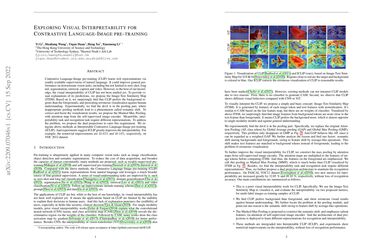Exploring Visual Interpretability for Contrastive Language-Image Pre-training
Contrastive Language-Image Pre-training (CLIP) learns rich representations via readily available supervision of natural language. It improves the performance of downstream vision tasks, including but not limited to the zero-shot, long tail, segmentation, retrieval, caption, and video. However, the visual explainability of CLIP is rarely studied, especially for the raw feature map. To provide visual explanations of its predictions, we propose the Image-Text Similarity Map (ITSM). Based on it, we surprisingly find that CLIP prefers the background regions than the foregrounds, and shows erroneous visualization results against human understanding. This phenomenon is universal for both vision transformers and convolutional networks, which suggests this problem is unique and not owing to certain network. Experimentally, we find the devil is in the pooling part, where inappropriate pooling methods lead to a phenomenon called semantic shift. For this problem, we propose the Explainable Contrastive Language-Image Pre-training (ECLIP), which corrects the explainability via the Masked Max Pooling. Specifically, to avoid the semantic shift, we replace the original attention pooling by max pooling to focus on the confident foreground, with guidance from free attention during training. Experiments on three datasets suggest that ECLIP greatly improves the explainability of CLIP, and beyond previous explainability methods at large margins. The code will be released later.
PDF Abstract

 ImageNet
ImageNet
 MS COCO
MS COCO
 ImageNet-S
ImageNet-S